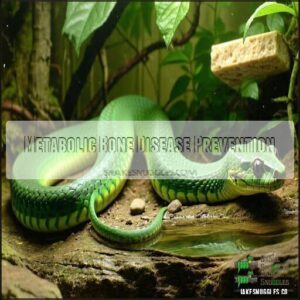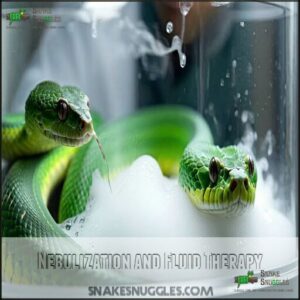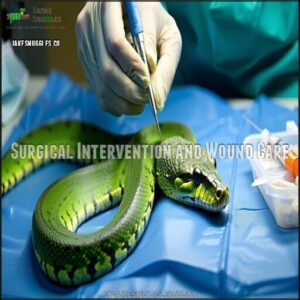This site is supported by our readers. We may earn a commission, at no cost to you, if you purchase through links.
 To improve snake health, start with a proper enclosure—make sure it’s the right size, keeps consistent temperatures, and has ideal humidity.
To improve snake health, start with a proper enclosure—make sure it’s the right size, keeps consistent temperatures, and has ideal humidity.
Clean it regularly; snakes aren’t fans of dirty homes either. Feed appropriately sized prey (nothing too big or too small) and only offer disease-free food.
Fresh water is a must for hydration, so don’t skip that.
Stress can harm snakes, so handle them gently and avoid unnecessary disruptions.
Don’t forget regular vet check-ups; a reptile-savvy vet can catch problems early. Think of it like preventative maintenance for your car—but with more hissing. Small things make a big difference long-term.
Table Of Contents
- Key Takeaways
- Improving Snake Health Basics
- How to Improve Snake Health
- Common Health Issues Prevention
- Effective Treatment and Care Strategies
- Long Term Snake Health Maintenance
- Frequently Asked Questions (FAQs)
- How do you keep a snake healthy?
- How can I reduce my risk of getting syphilis?
- How can a snake eat a healthy diet?
- What should I do if my snake is sick?
- What should I do if my snake eats a lot?
- Why is monitoring snake health important?
- How can I tell if my snake is sick?
- What are some specific symptoms of common illnesses in snakes?
- Why is shedding a concern for snake health?
- What are some signs of respiratory problems in snakes?
- Conclusion
Key Takeaways
- Keep your snake’s enclosure clean, maintain proper temperature and humidity, and provide ample hiding spots.
- Feed appropriately sized prey and hydrate your snake with fresh water daily to support digestion and overall health.
- Watch for signs of sickness, like lethargy or trouble shedding, and consult a reptile vet for regular check-ups and early intervention.
- Minimize stress by handling gently, offering environmental enrichment, and adapting care to your snake’s specific species needs.
Improving Snake Health Basics
Taking care of your snake starts with getting the basics right, like setting up the perfect habitat and offering proper nutrition.
Start with the essentials—perfect habitat, balanced diet, and clean care—to keep your snake healthy and thriving.
Keeping their environment clean, stress-free, and suited to their species guarantees they stay healthy and happy.
Proper Enclosure Setup
A good snake enclosure setup starts with the right size—your snake needs room to stretch, not a studio apartment.
Use temperature gradients for proper snake temperature control and humidity levels to mimic their natural habitat.
Add substrate options for burrowing, hiding places for security, and optional snake UVB lighting.
A proper setup considers appropriate enclosure dimensions for the snake species, creating a safe environment.
These essentials create a stress-free environment.
Balanced Diet and Nutrition
A healthy snake diet means meeting its nutritional requirements through nutrient-rich prey.
Offering prey variety keeps feeding interesting while addressing reptile nutrition needs. Don’t overlook supplementation needs, like calcium for bone health.
Hydration’s importance can’t be overstated—always provide fresh water. Monitor feeding frequency to avoid obesity.
A balanced diet guarantees your snake thrives, not just survives—it’s like a gourmet menu for reptiles. Some extreme diets can cause hormonal balance issues, leading to significant health problems, emphasizing the need for a well-planned reptile nutrition approach.
Regular Health Check-Ups
A snake’s health thrives with regular health check-ups, much like a car needing a tune-up.
Building a solid vet relationship guarantees access to expert veterinary care. Monitor changes by watching their weight and spotting unusual symptoms for early detection.
Schedule an annual checkup with a snake vet for preventative care.
- **Monitor weight weekly or monthly.
- **Observe for unusual behaviors or symptoms.
- **Prioritize annual veterinary visits.
Minimizing Stress and Environmental Enrichment
To reduce stress and encourage natural behaviors, focus on habitat complexity and enrichment variety.
Offer hiding spots, climbing branches, and safe spaces suited to your snake’s behavior.
Gentle, safe handling helps them adapt while minimizing stress.
Rotate environmental enrichment often—like new textures or scents—keeping things engaging.
A well-thought enclosure setup allows your snake to thrive, revealing its fascinating instincts.
This setup supports the snake’s overall well-being by providing a stimulating environment that encourages natural behaviors.
How to Improve Snake Health

Improving your pet’s overall care doesn’t have to feel overwhelming. Small steps can make a big difference. Start by learning your snake’s species needs—what works for a ball python mightn’t suit a corn snake.
Small changes in care lead to big improvements—understand your snake’s unique needs to help them thrive, not just survive.
Pay attention to snake humidity levels, temperature, and water quality to create a comfortable habitat. Preventative care, like regular enclosure cleaning and spot checks for illnesses, keeps infections at bay. And remember, ethical ownership isn’t about collecting snakes, but ensuring each one thrives.
Snakes can develop dermatitis, so it’s important to maintain proper hygiene. If your snake isn’t shedding well or seems inactive, don’t hesitate to act.
Give them the best chance at a healthy life by focusing on these areas:
- **Monitor their behavior and weight regularly.
- **Maintain proper snake humidity levels.
- **Provide fresh water consistently.
- **Address genetic predispositions early.
Common Health Issues Prevention
Keeping your snake healthy starts with preventing common issues through good care practices.
By maintaining a clean environment, proper diet, and stress-free handling, you’ll avoid many problems before they start, which is a key part of good care practices.
Respiratory Infections Prevention
Focus on snake respiratory infection prevention with proper humidity, temperature, and ventilation quality.
Maintain the snake enclosure hygiene at a superior level. Use quarantine protocols for new arrivals and consider probiotics or immune boosters for added health support.
Optimize ventilation importance to reduce stale air buildup. Maintaining proper humidity requires a reliable humidity gauge.
Check the table below for essential tips:
| Prevention Tip | Why It’s Important | Quick Fix |
|---|---|---|
| Proper humidity | Prevents lung issues | Use a humidity gauge |
| Temperature balance | Boosts immunity | Adjust heating elements |
| Ventilation quality | Reduces pathogens | Install air vents or fans |
| Hygiene maintenance | Removes bacteria | Spot clean and disinfect |
| Quarantine protocols | Stops spread of germs | Isolate new snakes |
Digestive Issues Prevention
After respiratory health, let’s talk food. Prevent digestive issues by focusing on proper hydration, prey size, and feeding frequency.
Here’s how:
- Feed prey no wider than 1.5x your snake’s diameter.
- Stick to a steady feeding schedule.
- Offer probiotics to support the gut microbiome.
- Avoid overfeeding to prevent regurgitation or impaction.
- Hydrate for smooth digestion and prevent constipation.
Skin and Scale Problems Prevention
If your snake’s shedding looks patchy or scales seem discolored, check humidity—low levels can cause snake shedding problems.
For mite prevention and skin health, keep enclosure hygiene of the highest standard by regularly cleaning the habitat.
Use gentle handling techniques to avoid injuries, and support their skin with proper lighting and supplementation benefits.
Clear, consistent care keeps snake skin issues minimal and health at its best! Recognizing signs of scale rot early can prevent severe complications.
Metabolic Bone Disease Prevention
Skin health matters, but reptile health, especially metabolic bone disease prevention, demands special care.
Provide UVB lighting to support calcium absorption, and maintain diet balance with calcium supplementation and occasional vitamin boosts.
Hydration importance can’t be overstated, and young snakes and those with genetic predispositions are more at risk, so keeping their environment prime guarantees long-term snake health.
Effective Treatment and Care Strategies
In terms of treating your snake’s health issues, prompt action and proper care make all the difference.
By using effective strategies like medications, quarantine, and supportive therapies, you can guarantee a smoother recovery and prevent complications.
Antibiotic Therapy and Medications
In the context of antibiotic therapy for treating reptiles, precision is key.
Always consult a reptile vet for accurate dosage calculation and drug interactions. Misusing antibiotics can lead to antibiotic resistance or medication side effects.
Effective reptile antibiotic treatments include:
- Broad-spectrum antibiotics like ceftazidime for infections.
- Probiotic support to aid gut health during treatment.
- Monitoring for adverse reactions.
- Customized medication options for diverse bacterial pathogens.
Nebulization and Fluid Therapy
When dealing with snake respiratory infection treatment, nebulization benefits include delivering antibiotics directly to the lungs, improving recovery.
Home nebulization uses saline or medications to clear mucus, and therapy duration depends on severity.
For dehydration, fluid therapy restores health, using different fluid types and administration methods.
Supportive care, like proper humidity, complements these treatments for faster healing and overall well-being.
Surgical Intervention and Wound Care
When medication doesn’t cut it, surgical intervention can save a snake’s life.
Whether it’s abscess drainage, foreign removal, or scale reconstruction, proper techniques like suturing between scales prevent long-term damage.
Use wound dressings and continue antibiotics for ulceration removal. Proper humidity levels are also essential for recovery.
Post-op care is critical—monitor healing closely, adjust the environment, and consult your vet to keep your snake slithering happily.
Quarantine and Isolation Procedures
After wound care, quarantine is key to snake health.
Separate newcomers or sick snakes to prevent cross-contamination.
Use these snake quarantine procedures:
- Set up a sterile isolation setup with proper temperature and humidity.
- Maintain a quarantine duration of 30-90 days.
- Sanitize tools after use to avoid disease spread.
- Monitor protocols for shedding, appetite, and droppings.
- Limit handling during quarantine.
Long Term Snake Health Maintenance
Keeping your snake healthy for the long haul means staying proactive with regular care and observation.
By fine-tuning their diet, monitoring their behavior, and providing a stress-free environment, you’ll set them up for a thriving life.
Regular Monitoring and Observation
Paying attention to appetite changes, shedding issues, and behavioral shifts is key to monitoring snake health.
Watch for skin abnormalities or weight fluctuations, as these snake symptoms could signal health issues.
Snakes often hide signs of illness, so regular behavior monitoring helps catch problems early.
Spotting subtle signs of illness guarantees you address snake health issues before they escalate, which is crucial for maintaining overall snake health and preventing severe problems through early detection.
Handling and Environmental Enrichment
Watching your snake’s behavior can tell you what works.
Safe handling reduces stress and builds trust, making it essential to snake health. Mix environmental enrichment like climbing branches, hides, and textures to encourage natural activity levels.
Offering enrichment variety prevents boredom, while gentle snake handling fosters social interaction.
A thoughtful snake habitat creates comfort, improving overall health and reducing inactivity, which is key to snake health and overall well-being.
Dietary Adjustments and Supplementation
A balanced diet keeps your snake healthy and active. Adjusting prey variety and using supplements guarantee proper nutrition.
Here’s how:
- Gut-load feeder insects with nutrient-rich foods.
- Use calcium sources to prevent metabolic bone disease.
- Include vitamin supplementation sparingly on a schedule.
- Avoid overfeeding for effective obesity prevention.
Proper preparation requires specialized feeding products. Don’t forget, hydrated snakes shed better, which is crucial for their overall health.
Veterinary Care and Consultations
Regular checkups with a reptile veterinarian help spot hidden issues early.
From snake diagnostic tests to medication administration, expert guidance guarantees proper treatments.
Quarantine protocols are key for new or sick snakes, limiting disease spread.
Supportive care, like maintaining humidity and temperature, complements veterinary care.
| Task | Purpose | Example |
|---|---|---|
| Routine Checkups | Early issue detection | Checking for respiratory signs |
| Diagnostic Tests | Confirming health problems | Bloodwork or fecal exams |
| Medication Administration | Treating illnesses | Prescribed antibiotics or antifungals |
Reorganizing the care process involves understanding the importance of routine checkups, diagnostic tests, and proper medication administration.
This structured approach ensures that snakes receive the best possible care, from early issue detection to recovery.
Frequently Asked Questions (FAQs)
How do you keep a snake healthy?
A snake’s health thrives with the right blend: a clean, cozy home, proper temperature, and humidity.
Feed it a species-appropriate diet, offer fresh water, handle gently, and schedule regular check-ups with a reptile vet!
How can I reduce my risk of getting syphilis?
To lower your risk of syphilis, use condoms consistently, limit sexual partners, and communicate openly about STI testing with them.
Regular check-ups catch issues early, making prevention and treatment easier.
Also, prioritize honesty and safe practices.
How can a snake eat a healthy diet?
Feeding your snake is like crafting the perfect meal plan—offer appropriately sized prey based on its species and age.
Make certain fresh water access, avoid overfeeding, and stick to a consistent schedule for digestion efficiency, which is crucial for the snake’s health and digestion efficiency.
What should I do if my snake is sick?
If your snake seems sick, consult a reptile vet immediately.
Monitor symptoms like lethargy, wheezing, or loss of appetite, and verify the enclosure’s temperature and humidity are ideal.
Follow treatment plans and provide supportive care.
What should I do if my snake eats a lot?
When your snake devours meals like it’s training for a food-eating contest, check its diet size and feeding schedule.
Overfeeding can cause obesity, so adjust portions, space meals, and make certain proper exercise to maintain health.
Why is monitoring snake health important?
Keeping an eye on your snake’s health helps you catch problems early, like abnormal shedding or weight loss.
Since snakes hide illnesses well, spotting changes quickly can mean the difference between simple fixes and serious issues.
How can I tell if my snake is sick?
Watch for signs like lethargy, reduced appetite, wheezing, odd movement, or skin issues like shedding problems.
Swollen gums, excessive saliva, and weight loss are red flags.
Trust your instincts—if something feels off, consult a vet.
What are some specific symptoms of common illnesses in snakes?
Think of your snake as a silent storyteller—watch for wheezing, open-mouth breathing, swollen gums, lethargy, regurgitation, or patchy shedding.
These subtle signs often scream illness, so act fast to guarantee they slither back to health.
Why is shedding a concern for snake health?
Shedding matters because it tells you if your snake’s hydrated and healthy.
Trouble shedding—like stuck skin—can signal low humidity, dehydration, or illness.
Regular checks and proper enclosure care make shedding smooth and stress-free.
What are some signs of respiratory problems in snakes?
Don’t ignore subtle signs like wheezing, open-mouth breathing, or excessive mucus around your snake’s nostrils.
If they seem sluggish or struggle to breathe, it’s time to act—these symptoms scream respiratory trouble needing attention.
Conclusion
Caring for a snake is like fine-tuning an instrument—when the basics are right, everything harmonizes.
To improve snake health, verify their enclosure suits their needs, offer a balanced diet, and provide clean water.
Minimize stress by handling them gently and keeping disruptions low.
Watch for early warning signs of illness and consult a reptile-savvy vet regularly.
By maintaining a clean, secure environment and prioritizing their well-being, you’ll guarantee a healthy, thriving snake for years to come, which is the ultimate goal of caring for these animals.
- https://familysnake.com/guides/sssuper-health-tips-for-your-happy-healthy-snake/
- https://zenhabitats.co.uk/pages/your-healthy-snake-1
- https://petadvocacy.org/wp-content/uploads/2022/01/Snakes-Care-Sheet.pdf
- https://www.quora.com/What-are-some-good-tips-for-keeping-pet-snakes-healthy
- https://amccorona.com/wp-content/uploads/2020/05/ARAV_trifold_ball_pythonv2_2.pdf
















